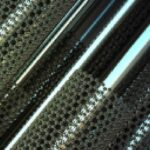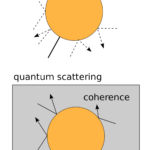During the optical excitation of carriers in a semiconductor, the minimum energy re‐ quired to form free carriers is called the band gap. The energy below that value cannot excite free carriers. However, low-temperature absorption studies of semiconductors have shown excitation just below the band gap [1]. This excitation is associated with the formation of an electron and an electron hole bound to each other, otherwise called an exciton. It is an electrically neutral quasiparticle like in a hydrogenic state. At low temperatures, the bound states are formed and the Coulomb interaction between the electron and the hole becomes prominent [2]. The negative trion (X-) is created due to the additional electron bound to a pre-existing exciton and if a hole is bound to an exciton, a positive trion (X+) is created. Both the negative and positive trions are complex electronic excited states of the semiconductors and therefore, the 3-body problem is raised. Although Lampert [3] in 1958 originally and theoretically predicted the negative trion in semiconductors, K.Kheng et al. experimentally achieved a negative trion in Cd Te/Cd Zn Te quantum well [4]. The rapid progress of semiconductor technology in the recent years has allowed the fabrication of low dimension electronic nanostructures. Such nanostructures confine charged particles in all three space dimensions. In low dimensional, especially in quantum dots [5,6] (three dimension confinement), the picture is different because it is below a nanometer wide, a few nanometers thick, and in various shapes. The quantum confinement increases highly, and this quantum confinement leads to more stability of the excitons and trions by increasing their binding energy. The stability of such particles remains up to room temperature. A proper identification of the (X-) was not achieved until the early 1990’s in remotely doped, high-quality quantum-well (QW) structures [7-9]. Since then, extensive work has been carried out on (X-) inside the two-dimensional (2D) [wide quantum wells [7-11]] and quantum dots, which the first observations of the QD-confined charged excitons (trions) were performed on ensembles of the QDs [12]. There are many theoretical studies devoted to excitons [13-15] and trions [16- 25] in quantum dot. Most of such studies have treated and considered the spherical[26-28], lens shaped [29,30], square flat plated [31,32], and cylindrical [33,34] quantum dots.
In the present chapter, we study the influence of the 3-D quantum confinement on the binding energy of the exciton (X), negative trion (X-), and the positive trion (X+) in a semiconductor cylindrical quantum dot manufactured in GaAs surrounded by Ga1-xAlxAs. Using a variational approach and the effective mass approximation with finite confinement – potential. There have been concerns as to whether the effective mass approximation could still be valid in the quantum dot limit when the size of the exciton could be similar to the average lattice constants of bulk semiconductor [35].
Theoretical model
Within the effective mass approximation and non-degenerated band approximation, we can describe the exciton and trions in the following semiconductor structure: a symmetric cylin‐ drical QD of radius R and height L made of GaAs surrounded by Ga1-xAlxAs. In our model, the electrons and the holes are placed in the external potential Ve(re, ze) and Vh (rh , zh ), respectively and coupled via Coulomb potential. We choose the potential in GaAs (well) to be zero and equals Ve or Vh in the barrier material.


























Conclusion
We have introduced a trial wave function for the positive and negative trions confined in a cylindrical QD. Using the given wave, we obtained a higher binding energy of negative trions than the positive trions inside the QD with a half-height less than the effective Bohr radius and we referred that to the high Coulomb interaction energy between the two electrons compared to the weak Coulomb interaction between two holes at such small QDs. When the half-height of the QD increased to values higher than the Bohr radius, the negative trion binding energy rapidly decreases than the binding energy of the positive trion. An anisotropic hole effective mass state is demonstrated to compare our model with the experimental results. We obtained a good agreement with the experimental results up to 0.3 meV (7%). To improve the stability of the trions (X −, X +), in such structures, it is necessary to operate with a special QD size, which permits an enhancement of the binding energy.


